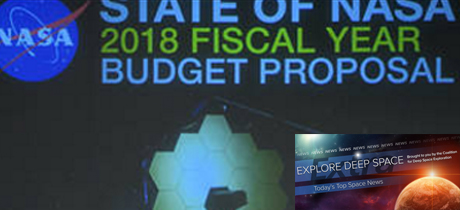In Today’s Deep Space Extra… Today features numerous stories focusing on the Trump Administration’s detailed 2018 budget proposal. Tomorrow’s edition will include an official statement from the Coalition for Deep Space Exploration.
Human Deep Space Exploration
NASA holding its own, but FY2018 request portrays murky future
Spacepolicyonline.com (5/24): NASA’s proposed budget for 2018 forecasts a flat top line of $19.06 billion for the space agency for each of the next five years, a limit that could challenge efforts to develop a Deep Space Gateway, a lunar-orbiting base to help prepare astronauts for the long journey to Mars. Proposed spending on the Space Launch System and Orion, the rocket and spacecraft to start astronauts on their way to the Martian realm, also reflect declines in appropriations for 2017.
ARM could live on without its arm
Air and Space Magazine (5/23): Though cancelled in the Trump Administration’s proposed 2018 budget, key elements of NASA’s Asteroid Redirect Mission (ARM) could live on to contribute to efforts to reach Mars with human explorers. Solar Electric Propulsion and a new high power solar array design could transition to NASA’s plans for a Deep Space Gateway, a lunar-orbiting space operations base that could help to prepare astronauts for the two to three year red planet journey.
White House proposes $19.1 billion NASA budget, cuts Earth science and education
Space News (5/23): NASA’s proposed 2018 budget, presented to Congress by the White House on Tuesday, totals $19.1 billion, a reduction from 2017. The spending plan trims funds for Earth science but increases investment in planetary sciences.
Space Science
Opportunity knocks! Farthest-driving Mars rover explores eroded valley
Space.com (5/23): NASA’s Opportunity rover, which landed on Mars in January 2004 with expectations of a 90-day mission, continues to explore the red planet for signs of past habitable environments. The golf cart sized rover is now in Perseverance, a valley-like feature that is part of the Endeavour Crater.
TRAPPIST-1’s seventh planet is a chilly world
Science News (5/23): Trappist-1, a nearby star with seven rocky planets, stirred visions of possible alien life relatively nearby when scientists announced the discovery in February. Now, astronomers contend the seventh planet is way too cold for biological activity in a research effort published this week in the journal Nature Astronomy.
Low Earth Orbit
Astronauts replace failed computer in short spacewalk
CBS News via Spaceflightnow.com (5/23): NASA astronauts Peggy Whitson and Jack Fischer replaced a faulty computer data relay box outside the International Space Station early Tuesday. The multiplexer demultiplexer (MDM) failed Saturday and the ISS mission management team called for the spacewalk a day later because of the crucial functions performed by the MDM. The spacewalk was the tenth for Whitson, tying her for the most by a U.S. astronaut.
China to form global satellite navigation system by 2020
Xinhuanet of China (5/23): China’s Beidou satellite navigation system should achieve global status by 2020, predicts Wang Li, chairman of the China Satellite Navigation System Committee.
Budget proposal puts NASA satellite servicing mission in doubt
Spaceflightnow.com (5/23): Restore-L, a NASA initiative to develop and fly a robotic satellite servicing mission, would give way to a joint effort with the Defense Advanced Research Projects Agency and the commercial sector under the Trump Administration’s 2018 budget proposal.

